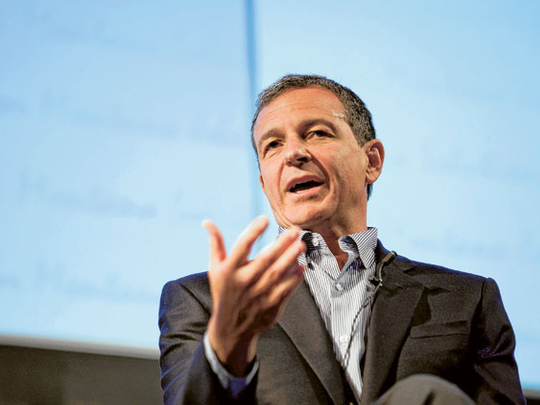
Los Angeles: Walt Disney chief executive Bob Iger will step down in March 2015 after nearly a decade at the helm, setting in motion a succession plan for the largest US media and entertainment company.
The company did not mention possible successors, but industry speculation centred on chief financial officer Jay Rasulo and the head of Disney's huge theme parks and resorts division, Tom Staggs.
Iger, 60, succeeded Michael Eisner as Disney's CEO in October 2005, which means his tenure as chief executive would be less than a decade long.
Eisner's reign at Disney, which ranks among the longest and most controversial in CEO history, lasted 21 years, from 1984 until 2005.
Disney shares fell 0.8 per cent to $31.77 (Dh116.69) in afternoon trading on the New York Stock Exchange on Friday. The company has increased in value by more than a third since Iger began his term.
Disney, which generates some $40 billion in annual revenue, is grappling with economic uncertainty and its impact on its three largest divisions: media, its movie studio and theme park resorts.
In August, the company posted better-than-expected quarterly results, but Wall Street analysts warned that low consumer spending may pinch in coming months.
"It's wise for Disney's board to have a very clear succession plan," said Miller Tabak and Co analyst David Joyce.
Still, he said, Iger's plan to leave the CEO post is "a little surprising given he's still a little young-ish CEO".
Speculation that Iger might have identified a successor picked up in 2009 after Disney said Staggs and Rasulo were swapping jobs.
Staggs, 50, was known as a favoured executive and is considered a potential successor to Iger, but the former Wall Street analyst lacked operational experience. By putting Staggs in charge of Disney's all-important theme parks, analysts said, Iger may have been affirming Staggs as a strong internal candidate for the top job while giving the finance chief much-needed operating experience.
Humble beginnings
Iger, who got his start as a TV weatherman, joined Disney after Eisner's deal to buy Capital Cities/ABC in 1995, a $19 billion deal that caught everyone flat-footed when announced. Iger served as Eisner's second-in-command for the last five years of his tenure.
His loyalty and deference to Eisner led to mocking from media insiders that Iger had no thought that Eisner did not already approve.
After taking over in 2005, however, Iger stunned the very same people with bold moves that betrayed his prior image. In a matter of months, he not only smoothed over the friction Eisner created with Apple co-founder Steve Jobs, but also convinced Jobs to sell Pixar animation studios to Disney for $7.4 billion.
In addition to the studio, that deal also made Jobs the company's largest individual shareholder and landed him on Disney's board, giving Iger unfettered access to Jobs' insights on how to re-orient an old media company to the digital world.
Iger rose to the CEO role in part because of disenchantment among investors at Eisner's leadership, particularly the way he handled the $66 billion hostile takeover offer from Comcast Corp in 2004.
At the company's annual shareholder meeting following that offer, Eisner received a stunning 43 per cent no-confidence vote from shareholders and was forced to relinquish his chairman of the board title.
Succession plan
Iger will assume the post of chairman, in addition to CEO, starting in March 2012, when chairman John Pepper retires. Iger will hold the jobs until March 31, 2015, and continue as executive chairman until June 30, 2016.
His annual salary rose to $2.5 million (Dh9.19 million) from $2 million now. Iger also could receive as much as $12 million in annual cash bonuses and up to $15.5 million a year in options and restricted shares.












